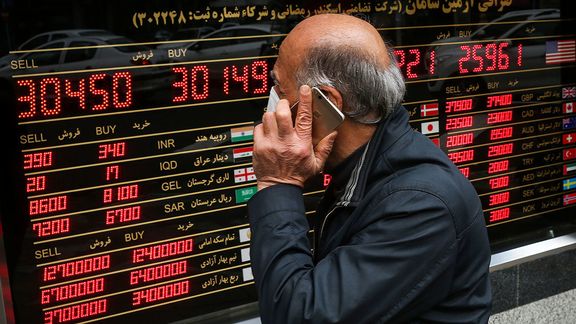Economist In Iran Says Big Chunk Of Crisis Due To US Sanctions

An Iranian economist says the role of US sanctions in causing economic chaos in Iran has been significant, as the national currency continued its free fall on Sunday.

An Iranian economist says the role of US sanctions in causing economic chaos in Iran has been significant, as the national currency continued its free fall on Sunday.
Iranian government officials, experts and the regime’s opponents have long argued that economic sanctions imposed by the Trump administration since 2018 inflicted a serious blow to Iran’s weak economy, but few have ventured to quantify the impact.
What is clear now is that Iran’s oil-dependent currency, the rial, fell from 35,000 to more than 600,000 against the US dollar in exactly five years. This led to very high inflation, officially at more than 50 percent, which has impoverished tens of millions of Iranians. But how much of the bad news was the result of sanctions and how much was the outcome of a natural trend in Iran’s state-controlled and inefficient economy.
Masoud Nili, an economist in Tehran believes that the impact of sanctions on the fall of the rial has been significant and serious. In a television program reported by Roouydad24 news website. Nili said that if the United States had not withdrawn from the JCPOA nuclear deal and imposed sanctions, the rial would be probably trading at 100,000 against the US dollar, instead of 600,000 and counting.
The economist based his estimate on trends since at least 2000 and concluded that the rial would have lost value in the past 5 years, but at a manageable pace.

Iran’s currency was trading at 70 to the dollar right before the 1979 revolution but in the 44 years since the establishment of the Islamic Republic it has steadily declined and now is headed toward a 10,000-fold fall in value.
But in Nili’s estimate, without the ‘Trump’s sanctions’ the Islamic Republic would have faced rial’s natural fall and not a catastrophic decline that it cannot control now.
The economist had a similar appraisal of the rate of inflation. Looking at trends in more than two decades he argued that the average annual inflation rate was around 16 percent, except in the past five years. The latest official figures put the inflation rate at more than 50 percent for January 2023, although there are no independent estimates.
Nili argued that the difference between the 16 percent average since the year 2000 and the current inflation rate is because of US sanctions.
But that difference is exactly what made the current situation an hyper-crisis instead of a weak economy limping along with the steady income from oil exports.
The Biden administration that assumed office criticizing the its predecessor’s decision to withdraw from the 2015 nuclear accord, also argued that sanctions have been ineffective and Tehran has expanded its nuclear program instead of making any concessions.
Critics on the other hand argued that sanctions take time to leave a serious impact and those imposed on Iran would have hardly worked in just two years from 2018-2020.
As the Biden administration entered talks with Tehran in April 2020 to revive the JCPOA, it did not suspend Trump’s sanctions and Iran struggled to sell oil and engage in in international trade. After depleting its foreign currency reserves, the economic situation began to quickly deteriorate, especially as optimism disappeared in the latter part of 2022 in the absence of a new nuclear deal with the US.